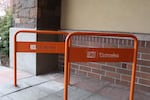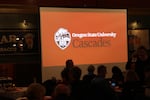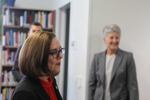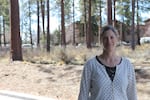
Oregon State University-Cascades is one of the state's fastest-growing public universities.
Rob Manning / OPB
The campus of Oregon State University-Cascades sits off Bend’s main drag in a part of the west side where there's plenty of room to grow. But the school is raising its profile, and endearing itself to locals, through events such as the “science pubs” the university throws at the local McMenamins.
Amy Herauf is a regular at these lectures.
“I love being able to come out to the pub and grab a drink and something to eat, and geek out, basically,” Herauf said with a laugh at one recent science pub.
She's a high school science teacher and comes to borrow ideas to share with students. But she said neither her students nor her colleagues and neighbors are that aware of OSU-Cascades.

"Science pub" events at the McMenamins' Old St. Francis School tavern in Bend are meant to connect campus professors with the local community.
Rob Manning / OPB
“I would say most people still associate Bend with the community college," she said. "So I don’t know if it’s quite caught on that it’s ‘university.'”
OSU is part of a changing landscape in higher education across the state and the county.
Related: Marylhurst University To Close Amid Shrinking Enrollment
The private Marylhurst University is closing amid financial problems, after well over a century near Lake Oswego. But the state's largest public university, Oregon State, is looking to expand through emerging branch campuses that are backed by taxpayer-funded bonds for construction.
OSU-Cascades started out as the place Central Oregon Community College students could finish a four-year degree.
The branch campus' top executive, OSU vice president Becky Johnson said the expansion of OSU-Cascades as a four-year university is a response to local demand.

Oregon Gov. Kate Brown (left, foreground) was among the state and local officials on hand to tour Oregon State University-Cascades and celebrate funding for a new building, in April 2018. She was joined by vice president Becky Johnson (right, background).
Rob Manning / OPB
"Bend has grown so fast that we would be the largest metropolitan area in the country without a four-year university if OSU-Cascades were not here,” Johnson said.
As Bend continues to grow, the challenge for the branch campus is how to mirror that without losing what’s working. Freshman Lauryn Gomez likes OSU-Cascades' current size, a comparatively small 1,200 students.
“One thing my family always says is I’m paying for a public education while I’m receiving a private education," she said.
Gomez is among the first students to live in the new campus residence hall, one of just three buildings on the equivalent of a few city blocks.
The plan is for OSU-Cascades to quadruple to 5,000 students by 2030 — a growth strategy that feels both exciting and bewildering to students such as Gomez. She's already thinking ahead to when she might come back as an alum and reflect on being part of the campus when it was a lot smaller.
"It's crazy just how big it's going to be — and how our part of the campus now is all that there is," she said. "In the future plans, it's just going to be a tiny corner."
Students who go to small liberal arts colleges often boast of the close relationships they have with professors, and that they feel less lost than their friends at big universities. But growth has its benefits.
"The magic number seems to be 2,500 students, and what we anticipate when we get there is we'll have sufficient capacity to offer classes multiple times each year," said OSU-Cascades academic dean Julie Gess-Newsome.
Gess-Newsome said there are many courses that are only offered once a year right now. When they're more frequently available, students don’t have to wait around for the course to show up on the calendar. Fewer delays mean students can graduate more quickly and, therefore, more cheaply.

Associate Vice President for Finance & Strategic Planning Kelly Sparks supervises the coordination and phasing of Oregon State University-Cascades' ambitious expansion effort.
Rob Manning / OPB
But expanding to get to 2,500 students or 5,000 students is not cheap.
A host of local and state officials descended on the Bend campus last month to celebrate the groundbreaking of Cascades' fourth building — funded largely by $39 million in state-backed bonds. That follows nearly $24 million in state bonds for a campus extension and different academic building. In both cases, the funding includes a local matching component or a campus revenue source.
OSU's own trustees approved $42 million in revenue bonds for the dining hall and dormitory, with room and board as the revenue sources.
Those millions in construction costs aren't coming from student tuition.
OSU-Cascades is taking steps to limit other costs. The campus is keeping its dry, natural landscapes rather than planting and watering grassy quads in an area that doesn't get a ton of rainfall.
They're cleaning up a closed landfill and making use of an old pumice mine. The landfill will be turned into parking lots and a home for solar panels. The pumice mine is planned to be terraced and become the "core academic part of campus," said Kelly Sparks, the associate vice president for finance & strategic planning. It's also planned to have an energy system called a "geoexchange," which combined with the solar array could create a "net-zero," or energy-independent, campus.
Johnson says the campus is rolling those local assets into learning opportunities — the east Cascade forests for natural science students and a planned energy system for future engineers to work on.
"If you're engaged in one experiential activity during your four years, your graduation rate goes from something like 65 percent to 85 percent; if you're engaged in two, it goes up into the 90s," Johnson said.
Of course, graduation is the goal — and it comes with a financial benefit. Graduation means a better job, and more capacity to pay off student loans.
Bend's booming tech sector isn't waiting for students to graduate.
Computer science major Ryan Kocjan splits time between studying and working as a junior. Kocjan said that balance was tough but rewarding.

Oregon State University-Cascades student Ryan Kocjan expects to graduate in 2018 with a degree in computer science.
Rob Manning / OPB
“Now I’m completely not doing that anymore," Kocjan said, laughing.
"This last year that I'm here, I'm focusing on school, because now I have the work experience and the connections, it's not going to be hard to transition back to a job."
Kocjan's professor, Yong Bakos, has so far connected all of his students with jobs. As OSU-Cascades grows, can he keep that up?
"Like any startup, so to speak, we're at a stage of scaling," Bakos said.
Bakos did the math in his head: a computer science program, with 5 percent of the student body, even if that reaches 5,000 students...
"That’s still very manageable, actually,” he said.
OSU-Cascades is expanding quickly. It will have two new buildings and two land expansions by 2021 when this fall's incoming freshmen are ready to graduate.

Oregon State University-Cascades has just three buildings, but an on-campus bike share system to help students get around, as the campus grows.
Rob Manning / OPB

